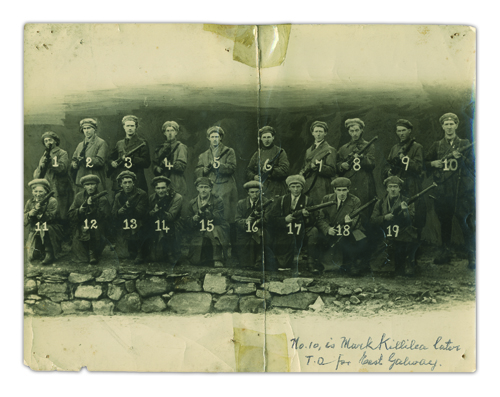Military Archives
Published in Features, Issue 3 (May/June 2014), Volume 22
IRA flying column, County Galway—from a series held within the Collins Papers called Captured Photographs. (Military Archives)
This archive won’t appeal to the pedigree nuts but is a treasure trove for those who want to document the experiences and motivations of ancestors who fought for independence or who have served in the Irish Defence Forces.
One of the problems in using this archive is that much of it concerns people born in the last 100 years, so the Data Protection Act applies. Consequently, Military Archives require proof that researchers are genuine and you will have to present evidence of kinship. This can be particularly onerous for a married woman tracing back two or more generations, and I found myself having to present a ‘mini-pedigree’, including my parents’ and grandparents’ marriage records.
Probably one of the largest collections held is the Defence Forces personnel records for every soldier and officer, comprising over 250,000 records from the foundation of the Irish state in 1922 to the present. The 30-year rule applies to the more recent material.
The Irish Defence Forces first paid out pensions in the late 1920s to anyone who could prove they had fought in the revolutionary period. As the Defence Forces were regularised in time of peace, formal records of service were established—the Military Service Pension Archive. In January 2014 the complete files of 3,200 individuals, mostly veterans of Easter Week 1916, were released. The complete collection pertains to 80,000 individuals, so there is much yet to come. The value to family history researchers is the copious information on family members, including spouses, children and other dependants.
The Bureau of Military History contains over 1,700 witness statements, compiled in the late 1940s and 1950s, from the formation of the Volunteers in 1913 to the cessation of the War of Independence on 11 July 1921. At its core are the transcripts taken from a widely representative section of those involved in the movement, overwhelmingly Volunteers but also including members of Cumann na mBan, the Irish Citizen Army, Sinn Féin and the IRB. In addition, there are transcripts for some non-combatants. One of my personal favourites is that of Bob Kinsella of Ferns, Co. Wexford, which starts in 1830! To the family historian these records are pure gold, as they provide detailed accounts not only of events but also of motives and state of mind. The Bureau also collected contemporary documents deemed important for posterity. They range from letters and documents to receipts, newspaper cuttings and ephemera saved or collected during the revolutionary period. These records are not yet on-line but there is an on-line catalogue.
The Collins Papers are administrative documents generated between 1919 and 1921, when Michael Collins was head of the IRB. Some also cover the ‘inter-regnum’ period, between the conclusion of the War of Independence in 1921 and the outbreak of the Civil War in 1922. They contain some grisly records, including from 1920 a daily incident report from the British Army with references to casualties amongst the Crown forces, but also lists of names of those killed by the IRA during this same period. There are also some files containing correspondence on individual cases, all of which relate to casualties identified in these lists. Some of these files are quite substantial and provide details of the capture and execution of those concerned, often coming directly from those involved. Many appear to have origi-nated in queries from family members. This is only the beginning of what this archive has to offer.
Fiona Fitzsimons is a director of Eneclann, a Trinity College campus company, and of findmypast Ireland.
















